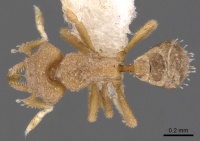Strumigenys hemisobek
| Strumigenys hemisobek | |
|---|---|

| |
| Scientific classification | |
| Kingdom: | Animalia |
| Phylum: | Arthropoda |
| Class: | Insecta |
| Order: | Hymenoptera |
| Family: | Formicidae |
| Subfamily: | Myrmicinae |
| Tribe: | Attini |
| Genus: | Strumigenys |
| Species: | S. hemisobek |
| Binomial name | |
| Strumigenys hemisobek (Bolton, 2000) | |
Known from the holotype worker collected " in moss on wet bank".
Identification
A member of the Strumigenys murphyi-group.
Bharti & Akbar (2013) - The species hemisobek belongs to a group which consists of 5 species (dyschima, formosa, hemisobek, murphyi and nannosobek). Members of the group constituted part of the former genus Epitritus, now abandoned (Baroni Urbani & de Andrade, 1994 & 2007; Bolton, 1999). The group is mostly distributed in the Oriental and Malesian regions. The most westerly member of the group yet discovered, hemisobek is easily distinguished from other members of the group by its lack of orbicular hairs on cephalic dorsum and lack of eyes (Bolton, 2000).
India - Interestingly the specimens collected in India have small, rudimentary eyes represented by small, black spots placed in the middle of the antennal scrobes posteriorly. These spots however are very much diffused. The dorsal surface of gaster bears reduced, erect hairs. The ventral spongiform tissue is also reduced in specimens from India.
Bolton (2000) - The most westerly member of the group yet discovered, hemisobek is easily distinguished from other members of the group by its lack of orbicular hairs and lack of eyes.
Keys including this Species
Distribution
Latitudinal Distribution Pattern
Latitudinal Range: 11.08333333° to 11.08333333°.
| North Temperate |
North Subtropical |
Tropical | South Subtropical |
South Temperate |
- Source: AntMaps
Distribution based on Regional Taxon Lists
Oriental Region: India, Nepal (type locality).
Distribution based on AntMaps
Distribution based on AntWeb specimens
Check data from AntWeb
Countries Occupied
| Number of countries occupied by this species based on AntWiki Regional Taxon Lists. In general, fewer countries occupied indicates a narrower range, while more countries indicates a more widespread species. |

|
Estimated Abundance
| Relative abundance based on number of AntMaps records per species (this species within the purple bar). Fewer records (to the left) indicates a less abundant/encountered species while more records (to the right) indicates more abundant/encountered species. |

|
Biology
|
Castes
Nomenclature
The following information is derived from Barry Bolton's Online Catalogue of the Ants of the World.
- hemisobek. Pyramica hemisobek Bolton, 2000: 452, figs. 265, 289 (w.) NEPAL. Combination in Strumigenys: Baroni Urbani & De Andrade, 2007: 121
Unless otherwise noted the text for the remainder of this section is reported from the publication that includes the original description.
Description
Worker
Holotype. TL 1.8, HL 0.42, HW 0.44, CI 105, ML 0.18, MI 43, SL 0.22, SI 50, PW 0.27, AL 0.46. Inner margin of mandible with 3-4 preapical teeth, the basalmost of which is located proximal of the midlength. A series of medially directed projecting spatulate hairs arises from the inner margin of each mandibular blade. Apicodorsal tooth the longest but at full closure does not project beyond the outer margin of the opposing mandible. Dorsum of head without orbicular hairs, without any standing pilosity. Eyes absent. Subbasal lobe of scape terminates in a single large scale-like hair that points anteriorly. Leading edge of scape distal to this large hair with 3-4 small spoon-shaped hairs that curve toward the base of the scape, beyond which are 2-3 minute hairs that curve toward its apex. Transverse ridge on vertex poorly developed, shallow, low and broadly convex; more obvious in profile than in full-face view and its apices not angled anteriorly toward the anterolateral corners of the occipital lobes. Upper scrobe margin in full-face view shallowly concave between frontal lobe and anterolateral angle of occipital lobe. Head finely reticulate-punctate. Pronotal dorsum reticulate-punctate, concave medially. Mesonotum in profile with only a small shallow median impression in its dorsal outline. Propodeal dorsum sloping steeply posteriorly to the lamella on the declivity. Dorsal alitrunk and waist segments without standing hairs but first gastral tergite with numerous short straight erect hairs that are weakly clavate apically.
Type Material
Holotype worker, Nepal: Maewa Khola, Sanghu, 2.x.1961, 6500 ft, in moss on wet bank (K. H. Hyatt) (The Natural History Museum).
References
- Baroni Urbani, C. & De Andrade, M.L. 2007. The ant tribe Dacetini: limits and constituent genera, with descriptions of new species. Annali del Museo Civico di Storia Naturale “G. Doria” 99: 1-191.
- Bharti, H. & Akbar, S.A. 2013. Taxonomic studies on the ant genus Strumigenys Smith, 1860 (Hymenoptera, Formicidae) with report of two new species and five new records including a tramp species from India. Sociobiology 60, 387-396 (doi:10.13102/sociobiology.v60i4.387-396).
- Bolton, B. 2000. The ant tribe Dacetini. Mem. Am. Entomol. Inst. 65: 1-1028 (page 452, figs. 265, 289 worker described)
- Subedi, I.P., Budha, P.B. 2019. Status of ant research and species first described from Nepal with new distribution records. Journal of Natural History Museum. 31:57-78.
- Subedi, I.P., Budha, P.B., Bharti, H., Alonso, L. 2020. An updated checklist of Nepalese ants (Hymenoptera, Formicidae). ZooKeys 1006, 99–136 (doi:10.3897/zookeys.1006.58808).
- Tang, K. L., Guénard, B. 2023. Further additions to the knowledge of Strumigenys (Formicidae: Myrmicinae) within South East Asia, with the descriptions of 20 new species. European Journal of Taxonomy 907, 1–144 (doi:10.5852/ejt.2023.907.2327).
References based on Global Ant Biodiversity Informatics
- Bharti H., S. A. Akbar. 2013. Taxonomic studies on the ant genus Strumigenys Smith, 1860 (Hymenoptera, Formicidae) with report of two new species and five new records including a tramp species from India. Sociobiology 60: 387-396.
- Bolton, B. 2000. The Ant Tribe Dacetini. Memoirs of the American Entomological Institute 65
- Dad J. M., S. A. Akbar, H. Bharti, and A. A. Wachkoo. 2019. Community structure and ant species diversity across select sites ofWestern Ghats, India. Acta Ecologica Sinica 39: 219–228.

